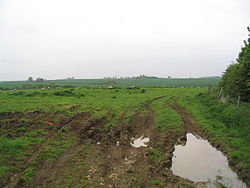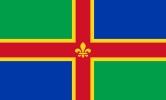Witham Preceptory
| South Witham Preceptory | |
|---|---|
 Site of South Witham Preceptory at Temple Hill | |
| Location | Temple Hill |
| Coordinates | 52°46′28″N 0°37′30″W / 52.7744°N 0.6251°W |
| OS grid reference | TF 08643032 |
| Founded | 1164 or earlier |
| Demolished | After 1540 |
| Reference no. | 325499 |
Location in Lincolnshire | |
The site of the former preceptory at Temple Hill, South Witham. It 'has been largely under pasture' since the Knights Templar left in 1308.[1]]] Withham Preceptory, one of the smallest Knights Templar preceptories in England, was founded, before 1164, at Temple Hill, near South Witham, Lincolnshire, and was abandoned in the early 14th century.[2]
Founding and establishment
Margaret Percy and Hubert de Rie were "great benefactors, if not founders" of the preceptory,[3] which began as "a simple hall with outbuildings" before 1164.[2] Development in the early 13th century led to a "regularly laid-out farmstead complex" comprising "two halls, a chapel, kitchens and agricultural and industrial buildings".[2] The site, which has the River Witham at the base of the hill, and the river's source, half a mile distant,[4] also included a water-mill, fishponds and "other water-control features".[2]
Chapel
The rectangular chapel, constructed between 1200 and 1220, was unusual for a Knights Templar preceptory,[5] as the Templars typically built distinctive rounded churches, to resemble the Church of the Holy Sepulchre at Jerusalem, a practice which "was unique in medieval England".[6] Its size was around 12.8 by 5 metres (42 by 16 ft), with a stairwell in the northwest corner, that may have led to a bell tower.[5] Two large footings, to the north of the altar, may be evidence of an Easter Sepulchre and a wall safe.[5] During 20th-century excavations, burial remains were found within the chapel: to the south, a body that had once been in a wooden coffin, the coffin having disintegrated over time, and, to the north, a body in a stone coffin without a lid.[5] A possibly corresponding stone coffin lid, dated to 1250, had been used, from around 1550, as part of a nearby footbridge over the River Witham, before being moved to the church of St John the Baptist at South Witham in 1905.[5]
Late 13th century
In the late 13th century the hall and chapel were rebuilt, the farmstead complex was expanded and enclosed by a wall.[1] The preceptory, at its largest, was: "Set about a great court, they had included a gatehouse on the north, a fine range of barns on the west, a domestic complex with hall, chambers, chapel and kitchen on the south-east, and a workshop area, with its ovens and kilns on the east."[7] In total, foundations for eighteen buildings have been located, ranging in size from 4 metres by 8 metres to 10 metres by 24 metres.[1] Remains have also been found for what has been interpreted as a kitchen garden, and also a hall keep, 'intended as a place of refuge in times of crisis'.[1]
Disestablishment and Knights Hospitaller
After the arrest of the Knights Templar in 1308, and the sequestering of their lands by the Crown,[7] records show the preceptory was occupied by eight famuli, or farm servants,[7] twelve ploughmen, a bailiff and three shepherds, all paid from nearby Temple Bruer.[8]
The Knights Templar order was formally disestablished by Pope Clement V,[9] in 1312, and the Witham preceptory was completely abandoned by 1324.[2] The lands passed to the Knights Hospitaller, who, in 1338, held a messuage (dwelling of some kind), eight carucates (units of ploughland) and moiety, in this case half the endowment,[10] of the South Witham church,[9] but are believed to have left the former preceptory uninhabited, and eventually incorporated the landholding into their estate at Temple Bruer.[2]
Later history
In 1563, after the Dissolution of the Monasteries, the property, then known as 'Great Temple', was granted, by Elizabeth I,[3] to Stephen Holford in 1562.[4] It was then owned, with 'buildings as it stood', by Thomas, the son of William Wimberley, of South Witham, (originally of Lancashire), and remained with that family 'until 1761, or thereabouts'.[11]
The preceptory site, recorded as uninhabited in the late 18th century,[2] along with the Wimberley's 'mansion, the post-house, and other lands', then passed to Lord William Manners, younger brother of John Manners, 3rd Duke of Rutland.[11] From Manners, it went to a descendant, Lionel Tollemache, 8th Earl of Dysart, who held possession in the mid-1800s.[11] Describing the preceptory in 1837, Thomas Moule wrote that the 'foundation of the building only remains, and they extend over several acres'.[4]
During the 1960s, archeological excavations commenced, which, as it had mainly been used for pasture, meant that 'post-medieval disturbance' had 'been minimal'.[2] Items found during the digs included a gilded ring, knights head belt buckle, arrowheads and horseshoes.[5]
A second archeological excavation took place in the area, in April 2002, following preliminary work in December 2000.[12] Evidence from the 11th to 15th century suggest large scale ironwork and bread-making in South Witham to supply local religious houses.[12] Template:Lincolnshire preceptories
References
- ^ a b c d Historic England. "Monument No. 325499". Research records (formerly PastScape). Retrieved 15 November 2013.
- ^ a b c d e f g h Historic England. "Remains of Knights Templar preceptory, watermill and fishponds, Witham (1007688)". National Heritage List for England. Retrieved 15 November 2013.
- ^ a b Thomas Tanner; John Tanner (1744). Notitia Monastica. Society for the Encouragement of Learning. p. 272.
- ^ a b c Thomas Moule (1837). The English Counties Delineated. Virtue. p. 195.
- ^ a b c d e f "Knights Templar Chapel". South Witham Archeological Group. Lincolnshire County Council. Retrieved 2013-11-15.
- ^ "Official Schedule Entry: Preceptory, boundary, two mounds, fishpond and dam at Beaumont Leys". Leicesters City Council. Retrieved 2013-11-15.
- ^ a b c Paul E. Szarmach; Teresa M. Tavormina; Joel T. Rosenthal (2013-01-11). Medieval England: A Social History and Archaeology from the Conquest to 1600 AD. Routledge. p. 39. ISBN 978-1-134-79453-9.
- ^ Norman Housley (2007-01-01). Knighthoods of Christ: Essays on the History of the Crusades and the Knights Templar, Presented to Malcolm Barber. Ashgate Publishing, Ltd. p. 204. ISBN 978-0-7546-5527-5.
- ^ a b Page (Editor), William. "66. THE PRECEPTORY OF SOUTH WITHAM". A History of the County of Lincoln. Vol. 2. British History Online. Retrieved 2013-11-15.
{{cite book}}:|last1=has generic name (help) - ^ B. Street (1857). Historical Notes on Grantham, and Grantham Church. S. Ridge. p. 57.
- ^ a b c Sylvanus Urban. (1852). The Gentleman's Magazine -- Volume 38. p. 486.
- ^ a b Kipling, Roger. "8 Church Lane South Witham, Lincolnshire: A Medieval Productive Site" (PDF). University of Leicester Archaeological Services. University of Leicester. Retrieved 2013-11-15.
Bibliography
- Antram N (revised), Pevsner N & Harris J, (1989), The Buildings of England: Lincolnshire, Yale University Press.
- Charles G. Addison The History of the Knights Templars (1997) ISBN 0932813402
- Larking, L B. and Kemble, J. M (1857), The Knights Hospitallers in England: Being a Report of the Prior Philip de Thame to the Grand Master Elyan de Villanova for A.D. 1338 Camden Society, pp.153-156
- Mayes, P., (2002), Excavations at a Templar Preceptory, South Witham, Lincolnshire 1965-67 (English Heritage: Society for Medieval Archaeology Monograph)
- Mills, D. The Knights Templar in Kesteven North Kesteven District Council (c.1990)
- Sister Elspeth (1906) in Page, William,(ed). A History of the County of Lincoln Volume 2. Victoria County History. pp. 210–213 Houses of Knights Templars: Willoughton, Eagle, Aslackby, South Witham and Temple Bruer.



